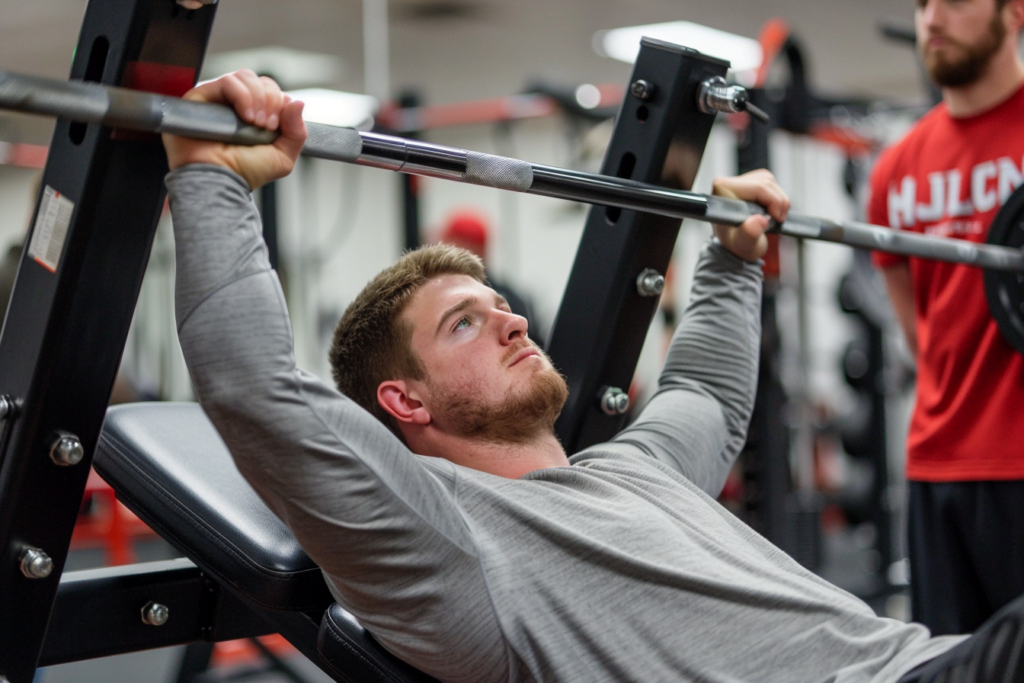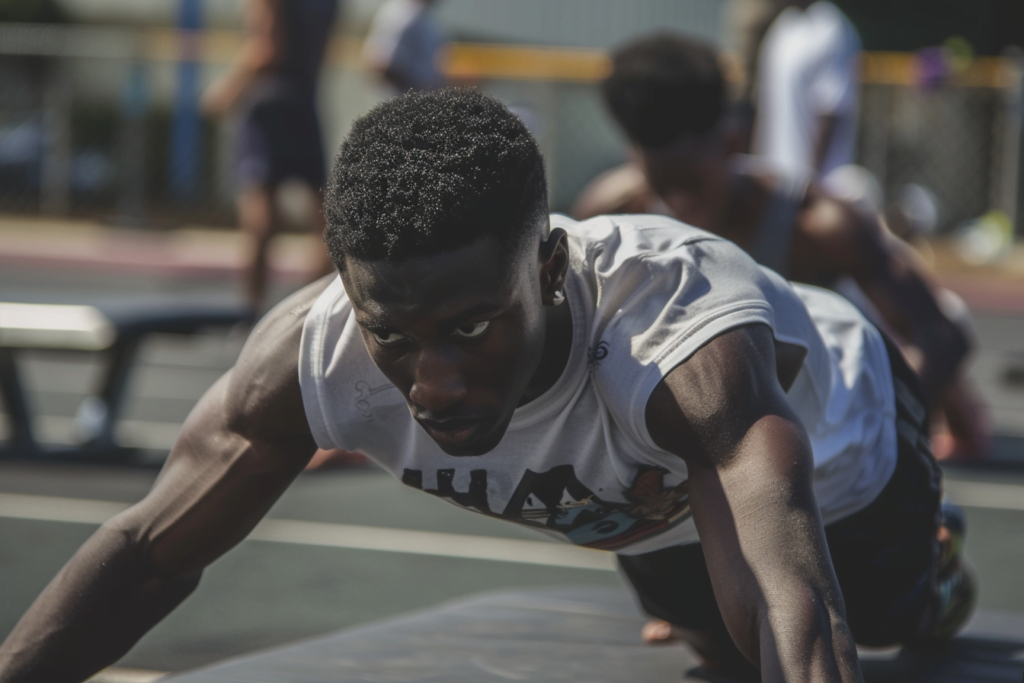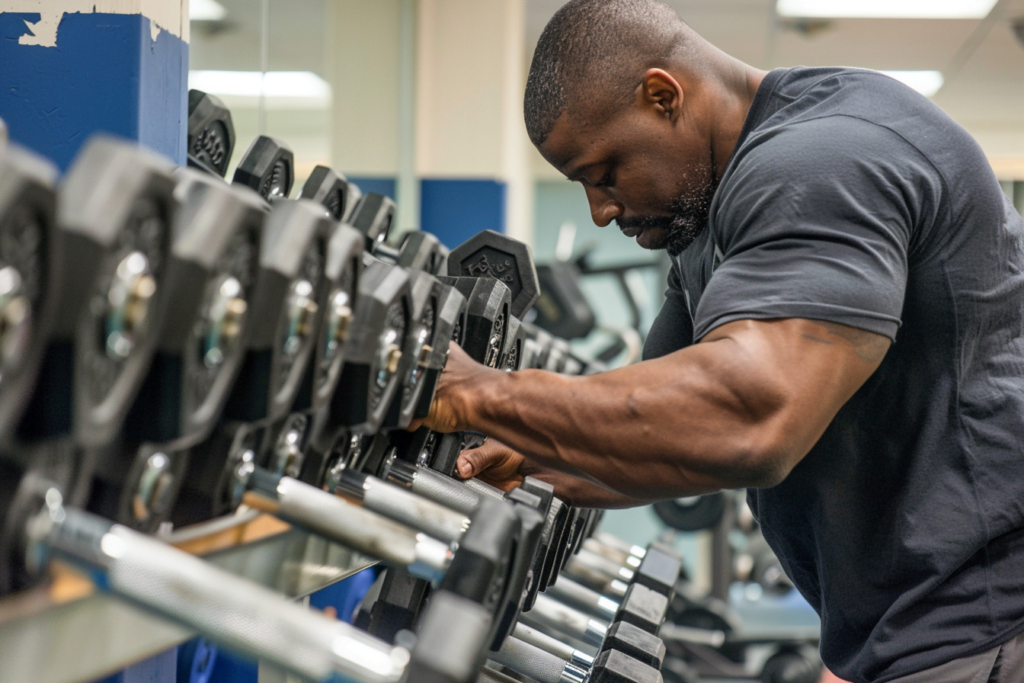
Compound chest exercises are a key component of any effective upper body workout routine. These exercises engage multiple muscle groups simultaneously, making them highly efficient for building strength and muscle mass. By incorporating compound chest exercises into a workout regimen, individuals can target the chest, shoulders, and triceps in a single movement, leading to comprehensive upper body development.
When performed correctly, compound chest exercises can contribute to improved functional strength and enhanced muscle coordination. They are particularly beneficial for individuals seeking to increase overall upper body strength and muscle definition. Understanding the proper form and technique for each exercise is crucial to maximising the benefits and minimising the risk of injury.
Contents
Fundamentals of Compound Chest Exercises
Compound chest exercises are an essential part of any chest workout routine. These exercises work multiple muscle groups at once, making them more efficient and effective than isolation exercises that only work one muscle group at a time.
When performing compound chest exercises, it is important to maintain proper form to avoid injury and ensure that the correct muscles are being targeted. This can be achieved by engaging the core, keeping the back straight, and using a weight that is appropriate for the individual’s strength level.
Some of the most popular compound chest exercises include the bench press, push-ups, dips, and dumbbell flyes. Each of these exercises works the chest muscles in slightly different ways, allowing for a well-rounded workout that targets all areas of the chest.
In addition to building strength and muscle mass, compound chest exercises also provide a number of other benefits. They can help improve posture, increase bone density, and boost overall fitness levels.
Overall, incorporating compound chest exercises into a workout routine is an excellent way to achieve a strong, defined chest and improve overall physical health.
Top Compound Chest Exercises
When it comes to building a strong and defined chest, compound exercises are the way to go. These exercises work multiple muscle groups at once, leading to greater muscle activation and overall strength gains. In this section, we’ll explore some of the top compound chest exercises that you can incorporate into your workout routine.
Bench Press Variations
The bench press is a classic exercise that targets the chest, shoulders, and triceps. There are several variations of the bench press, each with its own benefits. The flat bench press is a great all-around exercise that targets the entire chest. The incline bench press targets the upper chest, while the decline bench press targets the lower chest. To perform a bench press, lie on a bench with your feet flat on the ground and your hands gripping the barbell. Lower the bar to your chest and press it back up to the starting position.
Push-Up Variations

Push-ups are a great bodyweight exercise that can be done anywhere, anytime. There are several push-up variations that target the chest, shoulders, and triceps. The standard push-up targets the entire chest, while the wide-grip push-up targets the outer chest. The diamond push-up targets the triceps and inner chest. To perform a push-up, start in a plank position with your hands shoulder-width apart. Lower your body until your chest touches the ground and then push back up to the starting position.
Dumbbell Exercises

Dumbbell exercises are a great way to add variety to your chest workout. The dumbbell bench press targets the chest, shoulders, and triceps. The dumbbell fly targets the inner chest. To perform a dumbbell bench press, lie on a bench with your feet flat on the ground and a dumbbell in each hand. Lower the dumbbells to your chest and press them back up to the starting position. To perform a dumbbell fly, lie on a bench with your feet flat on the ground and a dumbbell in each hand. Extend your arms out to the sides and then bring them back together over your chest.
Incorporating these compound chest exercises into your workout routine can help you build a strong and defined chest. Remember to start with a weight that you can handle and gradually increase the weight as you get stronger.
Techniques for Maximising Muscle Engagement
When performing compound chest exercises, it is essential to use proper form and technique to maximise muscle engagement. Here are a few techniques that can be used to ensure optimal muscle activation:
1. Mind-muscle Connection
The mind-muscle connection is the ability to focus on the muscle being worked during an exercise. This technique involves consciously contracting the targeted muscle group throughout the exercise. By focusing on the muscle being worked, the individual can ensure that the muscle is being activated to its fullest potential. This technique is especially useful during compound exercises because it allows the individual to isolate the chest muscles while still engaging other muscle groups.
2. Range of Motion
The range of motion is the distance that a joint can move through its full motion. When performing compound chest exercises, it is essential to use a full range of motion to maximise muscle engagement. By using a full range of motion, the individual can ensure that the chest muscles are being fully activated throughout the exercise. Additionally, using a full range of motion can help to prevent injury and improve flexibility.
3. Proper Breathing
Proper breathing is essential when performing compound chest exercises. The individual should inhale during the eccentric phase (lowering the weight) and exhale during the concentric phase (lifting the weight). This technique helps to maximise muscle engagement by ensuring that the individual is using the correct muscles during each phase of the exercise. Additionally, proper breathing can help to prevent injury and improve overall performance.
4. Progressive Overload
Progressive overload is the gradual increase of stress placed on the body during exercise. This technique involves increasing the weight or resistance used during an exercise over time. By progressively increasing the weight used during compound chest exercises, the individual can ensure that the chest muscles are being challenged to their fullest potential. Additionally, progressive overload can help to prevent plateaus in muscle growth and improve overall strength.
Programming Compound Chest Workouts
Compound chest exercises are an excellent way to build a strong and muscular chest. However, to get the most out of these exercises, it is important to program your workouts effectively. In this section, we will discuss some key considerations when programming compound chest workouts.
Workout Splits
When programming compound chest workouts, it is important to consider the overall workout split. This refers to how you divide your workouts throughout the week. There are many different workout splits that you can use, but some common ones include:
- Full-body workouts: In these workouts, you train your entire body in each session. This can be a good option for beginners or those who have limited time to train.
- Upper/lower splits: In these workouts, you divide your training into upper-body and lower-body sessions. This can be a good option for intermediate or advanced lifters.
- Push/pull/legs splits: In these workouts, you divide your training into push (chest, shoulders, triceps), pull (back, biceps), and legs sessions. This can be a good option for intermediate or advanced lifters.
When programming compound chest workouts, it is important to choose a workout split that allows you to train your chest effectively while also balancing your overall training.
Volume and Intensity
Another important consideration when programming compound chest workouts is volume and intensity. Volume refers to the total amount of work that you do, while intensity refers to how heavy the weight is that you are lifting.
When it comes to volume, research has shown that doing more sets per week can lead to greater muscle growth. However, it is important to increase volume gradually to avoid overtraining. A good starting point for compound chest exercises is 3-4 sets per week.
When it comes to intensity, research has shown that lifting heavy weights (i.e. 80-85% of your one-rep max) can lead to greater muscle growth. However, it is important to balance intensity with volume to avoid injury and overtraining. A good starting point for compound chest exercises is to use a weight that allows you to perform 8-12 reps per set.
Overall, when programming compound chest workouts, it is important to consider your workout split, volume, and intensity to ensure that you are training effectively and safely.
Safety and Injury Prevention
When it comes to performing compound chest exercises, safety should always be a top priority. While these exercises can be highly effective for building strength and muscle mass, they can also be risky if not performed correctly.
One of the most important things to keep in mind is proper form. This means using the correct technique for each exercise and avoiding any movements that could put unnecessary strain on the chest or other muscles. It is also essential to use an appropriate amount of weight and to gradually increase the weight as strength improves.
In addition to using proper form, it is also important to warm up before starting any exercise routine. This can help to prevent injuries and prepare the muscles for the workout ahead. A good warm-up should include some light cardio and stretching exercises, as well as some dynamic movements to get the blood flowing to the muscles.
Another important consideration is to avoid overtraining. While it can be tempting to push yourself to the limit, doing too much too soon can lead to injury and burnout. It is important to listen to your body and to give yourself plenty of time to rest and recover between workouts.
By following these simple guidelines, it is possible to enjoy the benefits of compound chest exercises while minimizing the risk of injury. With proper technique, a sensible workout routine, and a commitment to safety, anyone can achieve their fitness goals and build a stronger, healthier body.
Frequently Asked Questions
What exercises can effectively target multiple muscle groups in the chest area?
Compound chest exercises are the best way to target multiple muscle groups in the chest area. These exercises involve the use of multiple joints and muscle groups, making them more efficient and effective than isolation exercises. Some of the best compound chest exercises include the barbell bench press, the dumbbell bench press, and the incline bench press.
How can one perform compound chest workouts at home without equipment?
There are several compound chest exercises that can be performed at home without equipment. These include push-ups, chest dips, and the diamond push-up. Push-ups are a great way to engage the chest muscles, while chest dips work the lower chest muscles. The diamond push-up is a challenging variation of the traditional push-up that targets the chest muscles and triceps.
Which dumbbell exercises are considered best for developing the chest as part of a compound workout?
Dumbbell exercises are a great way to develop the chest as part of a compound workout. Some of the best dumbbell exercises for developing the chest include the dumbbell bench press, the incline dumbbell press, and the dumbbell fly. These exercises work the chest muscles, as well as the shoulders and triceps.
Can you combine chest and triceps training in a single compound movement, and if so, which exercises achieve this?
Yes, chest and triceps training can be combined in a single compound movement. The best exercises for achieving this include the close-grip bench press, the dips, and the push-ups. These exercises work the chest and triceps muscles simultaneously, making them more efficient and effective than isolation exercises.
What are the fundamental differences between compound and isolation exercises when focusing on chest development?
The fundamental difference between compound and isolation exercises when focusing on chest development is the number of muscle groups that are engaged during the exercise. Compound exercises involve the use of multiple muscle groups and joints, making them more efficient and effective than isolation exercises. Isolation exercises, on the other hand, target a specific muscle group and are less effective at engaging multiple muscle groups.
In what ways do compound chest exercises with weights differ from those that utilise bodyweight?
Compound chest exercises with weights differ from those that utilise body weight in several ways. Weighted exercises are generally more challenging than bodyweight exercises, as they require the use of additional resistance. Weighted exercises are also more effective at building muscle mass and strength, as they allow for progressive overload. Bodyweight exercises, on the other hand, are more convenient and can be performed anywhere, without the need for equipment.
